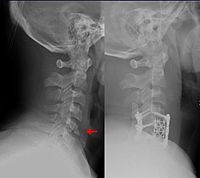
Photo from wikipedia
OBJECTIVE To optimize rapid clinical recovery and restoration of function and functionality, permissive weight-bearing has been designed as a new aftercare mobilization regimen, within the upper boundary of the therapeutic… Click to show full abstract
OBJECTIVE To optimize rapid clinical recovery and restoration of function and functionality, permissive weight-bearing has been designed as a new aftercare mobilization regimen, within the upper boundary of the therapeutic bandwidth, yet safe enough to avoid overloading. The aim of the present paper is to describe a comprehensive protocol for permissive weight-bearing during allied health therapy and to report on the time to full weight-bearing, as well as the number of complications, in patients with surgically treated fractures of the pelvis and lower extremities undergoing permissive weight-bearing. PATIENTS AND METHODS This study included surgically treated trauma patients with (peri)- or intra-articular fractures of the pelvis and lower extremities. A standardized permissive weight-bearing protocol was used for all patients. Time to full weight-bearing and number of complications were recorded. RESULTS This study included 150 patients, 69% male, with a median age of 48 years (interquartile range (IQR) 33.0, 57.0). The median time to full weight bearing was 12.0 weeks (IQR 6.8, 19.2). The complication rate during rehabilitation was 10%. CONCLUSION The permissive weight-bearing protocol, as described, might be beneficial and has potential to be implemented in trauma patients with surgically treated (peri)- or intra-articular fractures of the pelvis and lower extremities.
Journal Title: Journal of rehabilitation medicine
Year Published: 2019
Link to full text (if available)
Share on Social Media: Sign Up to like & get
recommendations!